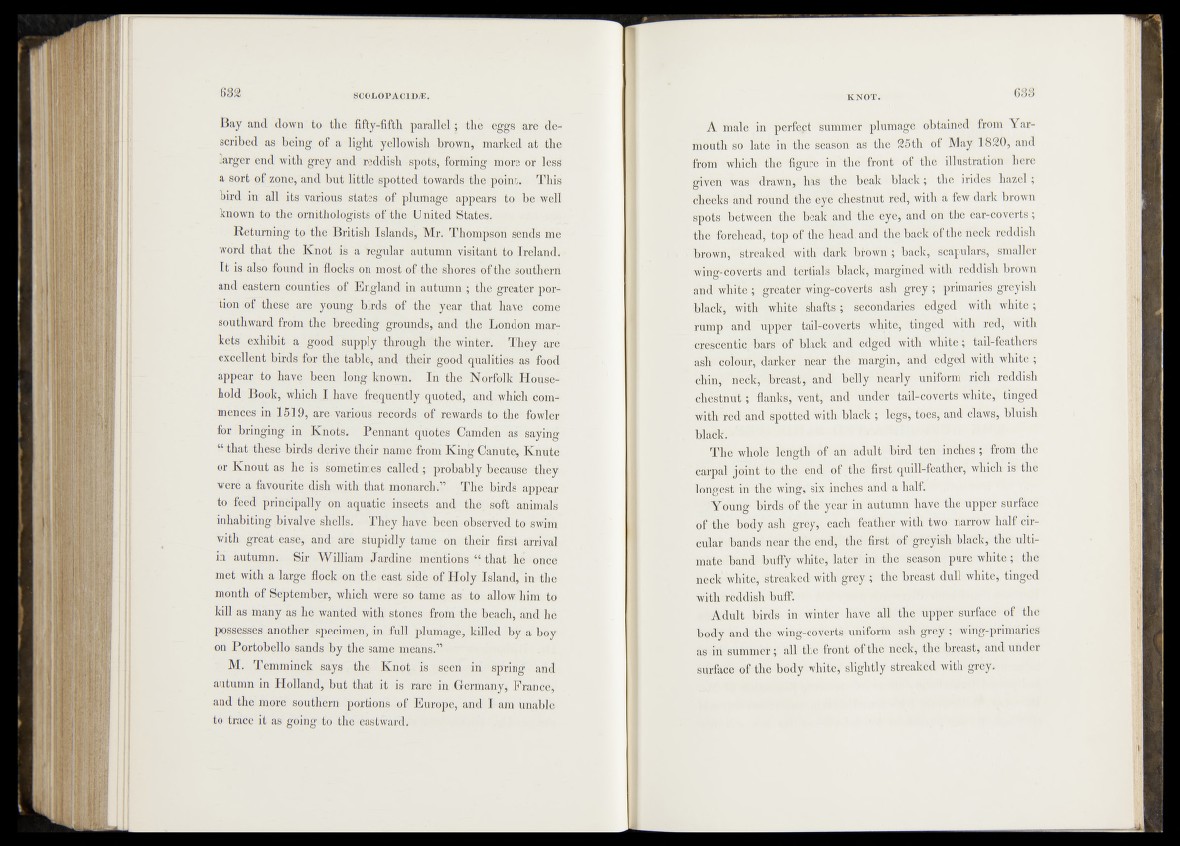
Bay and down to the fifty-fifth parallel; the eggs are described
as being of a light yellowish brown, marked at the
larger end with grey and reddish spots, forming more or less
a sort of zone, and but little spotted towards the point. This
bird in all its various states of plumage appears to be well
known to the ornithologists of the United States.
Returning to the British Islands, Mr. Thompson sends me
word that the Knot is a regular autumn visitant to Ireland.
It is also found in flocks on most of the shores of the southern
and eastern counties of England in autumn ; the greater portion
of these are young birds of the year that have come
southward from the breeding grounds, and the London markets
exhibit a good supply through the winter. They are
excellent birds for the table, and their good qualities as food
appear to have been long known. In the Norfolk Household
Book, which I have frequently quoted, and.which commences
in 1519, are various records of rewards to the fowler
for bringing in Knots. Pennant quotes Camden as saying
“ that these birds derive their name from King Canute, Knute
or Knout as he is sometimes called; probably because they
were a favourite dish with that monarch.” The birds appear
to feed principally on aquatic insects and the, soft animals
inhabiting bivalve shells. They have been observed to swim
with great ease, and are stupidly tame on their first arrival
in autumn. Sir William Jardine mentions “ that he once
met with a large flock on the east side of Holy Island, in the
month of September, which were so tame as to allow him to
kill as many as he wanted with stones from the beach, and he
possesses another specimen, in full plumage, killed by a boy
on Portobello sands by the same means.”
M. Temminck says the Knot is seen in spring and
autumn in Holland, but that it is rare in Germany* France,
and the more southern portions of Europe, and I am unable
to trace it as going to the eastward.
A male in perfect summer plumage obtained from Yarmouth
so late in the season as the 25th of May 1820, and
from which the figure in 'the front of the illustration here
given was drawn, has the beak black;O | the irides hazel;
cheeks and round the eye chestnut red, with a few dark brown
spots between the beak and the eye, and on the ear-coverts;
the forehead, top of the head, and the back of the neck reddish
brown, streaked with dark brown; back, scapulars, smaller
wing-coverts and tertials black, margined with reddish brown
and white; greater wing-coverts ash grey ; primaries greyish
black, with white shafts; secondaries edged with white;
rump and upper tail-coverts white, tinged with red, with
crescentic, bars of black and edged with white; tail-feathers
ash colour, darker near the margin, and edged with white ;
chin, neck, breast, and belly nearly uniform rich reddish
chestnut; flanks, vent, and under tail-coverts white, tinged
with red and spotted with black ; legs, toes, and claws, bluish
black.
The whole length of an adult bird ten inches; from the
carpal joint to the end of the first quill-feather, which is the
longest in the wing, six inches and a half.
Young birds of the year in autumn have the upper surface
of the body ash grey, each feather with two narrow half circular
bands near the end, the first of greyish black, the ultimate
band buffy white, later in the season pure white; the
neck' white, streaked with grey ; the breast dull white, tinged
with reddish buff.
Adult birds in winter have all the upper surface of the
body and the wing-coverts uniform ash grey ; wing-primaries
a$ in summer; all the front of the neck, the breast, and under
surface of the body white, slightly streaked with grey.